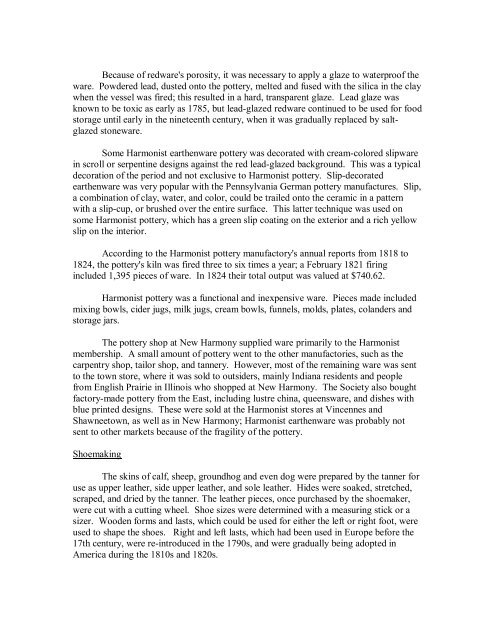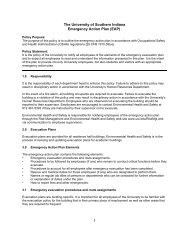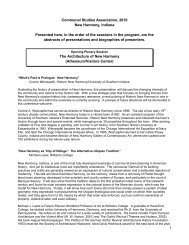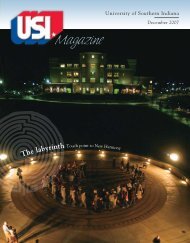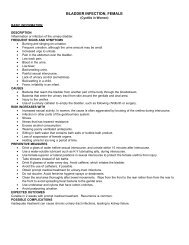The Harmonie Society - University of Southern Indiana
The Harmonie Society - University of Southern Indiana
The Harmonie Society - University of Southern Indiana
You also want an ePaper? Increase the reach of your titles
YUMPU automatically turns print PDFs into web optimized ePapers that Google loves.
Because <strong>of</strong> redware's porosity, it was necessary to apply a glaze to waterpro<strong>of</strong> the<br />
ware. Powdered lead, dusted onto the pottery, melted and fused with the silica in the clay<br />
when the vessel was fired; this resulted in a hard, transparent glaze. Lead glaze was<br />
known to be toxic as early as 1785, but leadglazed redware continued to be used for food<br />
storage until early in the nineteenth century, when it was gradually replaced by salt<br />
glazed stoneware.<br />
Some Harmonist earthenware pottery was decorated with creamcolored slipware<br />
in scroll or serpentine designs against the red leadglazed background. This was a typical<br />
decoration <strong>of</strong> the period and not exclusive to Harmonist pottery. Slipdecorated<br />
earthenware was very popular with the Pennsylvania German pottery manufactures. Slip,<br />
a combination <strong>of</strong> clay, water, and color, could be trailed onto the ceramic in a pattern<br />
with a slipcup, or brushed over the entire surface. This latter technique was used on<br />
some Harmonist pottery, which has a green slip coating on the exterior and a rich yellow<br />
slip on the interior.<br />
According to the Harmonist pottery manufactory's annual reports from 1818 to<br />
1824, the pottery's kiln was fired three to six times a year; a February 1821 firing<br />
included 1,395 pieces <strong>of</strong> ware. In 1824 their total output was valued at $740.62.<br />
Harmonist pottery was a functional and inexpensive ware. Pieces made included<br />
mixing bowls, cider jugs, milk jugs, cream bowls, funnels, molds, plates, colanders and<br />
storage jars.<br />
<strong>The</strong> pottery shop at New Harmony supplied ware primarily to the Harmonist<br />
membership. A small amount <strong>of</strong> pottery went to the other manufactories, such as the<br />
carpentry shop, tailor shop, and tannery. However, most <strong>of</strong> the remaining ware was sent<br />
to the town store, where it was sold to outsiders, mainly <strong>Indiana</strong> residents and people<br />
from English Prairie in Illinois who shopped at New Harmony. <strong>The</strong> <strong>Society</strong> also bought<br />
factorymade pottery from the East, including lustre china, queensware, and dishes with<br />
blue printed designs. <strong>The</strong>se were sold at the Harmonist stores at Vincennes and<br />
Shawneetown, as well as in New Harmony; Harmonist earthenware was probably not<br />
sent to other markets because <strong>of</strong> the fragility <strong>of</strong> the pottery.<br />
Shoemaking<br />
<strong>The</strong> skins <strong>of</strong> calf, sheep, groundhog and even dog were prepared by the tanner for<br />
use as upper leather, side upper leather, and sole leather. Hides were soaked, stretched,<br />
scraped, and dried by the tanner. <strong>The</strong> leather pieces, once purchased by the shoemaker,<br />
were cut with a cutting wheel. Shoe sizes were determined with a measuring stick or a<br />
sizer. Wooden forms and lasts, which could be used for either the left or right foot, were<br />
used to shape the shoes. Right and left lasts, which had been used in Europe before the<br />
17th century, were reintroduced in the 1790s, and were gradually being adopted in<br />
America during the 1810s and 1820s.


